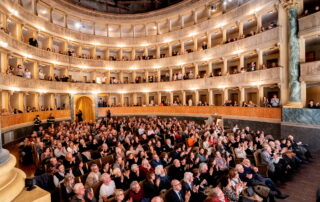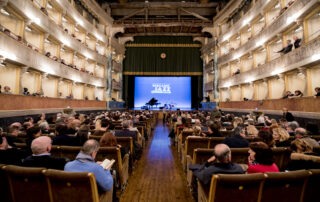In the 19th century, Italian theaters were the heart of entertainment and social gagherings in every town. There wasn’t a single town that did not own at least one theatre, often built as a sign of political and social prominence. Sociale Theater welcomed great personalities, high officials, national and international artists and, above all, opera singers, who were the real stars of those days. It’s an Italian-style theatre and it’s actually the fifth biggest theatre of this kind in Lombardy, after La Scala and Canobbiana in Milan, the Riccardi here in Bergamo and the theatre in Monza. It has always been different though: all the others are horseshoe-shaped, whereas it is oval, a shape that most probably is of French inspiration.
Sociale Theater has 82 boxes over three levels, plus the upper circle. Each box (owned by noble families) had a small dressing room, which were used by the owners in different ways. In the ball season, just like other theatres, it used to take off the seats and leave all the space for dancing, even when it had costume parties.
The whole roof has a long and complex history. After the first years of thriving activity, theatre went through tough times. It all became more difficult when the Municipality decided to cut the funds that it received annually: producing the shows was very expensive, it couldn’t be done with the money coming from the box owners only. This led to a slow but steady downfall, which affected the Upper town in general. At the end of the 19th century, the Lower town became more and more attractive: the town hall moved there and a new gateway, Porta Nuova, was built. Most importantly, the railway station connecting Bergamo to Milan was in the Lower town.
At the turn of the century, Sociale Theater opened up to various types of performance: operetta, cinema, gramophone shows. It was officially closed in 1932, but since 1929 it had only hosted scattered events, mostly for charity. In 1938, it was purchased by the Fascist National Party and a truly dark period started. Theater was almost demolished: they tried more than once. It’s almost unbelievable that it’s still standing. Two projects were designed, aiming to tear down everything but the foyer and the noble rooms. This didn’t happen simply because World War Two started, and there were no funds available.
After the war, Sociale became public property but things were not much better. In 1947 and 1961, two projects aimed at transforming it into a cinema, although it was already hosting film screenings. In 1963, it was purchased by the cathedral parish, then in 1976 it was the Municipality of Bergamo who finally bought it. Theatre was in a very bad shape: thoughout the 20th century roof was damaged and water had been seeping through, affecting the ceiling and the decorations of the boxes. There were endless debates, as nobody wanted it to keep functioning as a theatre. At some point, the idea was to make it part of the adjacent University premises. Then finally in 1978 a decision was made to repair my roof. After these restoration works, in the Eighties Sociale Theater hosted several exhibitions and events. At the beginning of this new century, its life started again: since 2009, it has regularly functioned as a theatre for opera, drama and other types of performances.
STALLS
Gaetano Donizetti play on the stage not as a composer, but as a young boy, when he was studying music here in Bergamo. It was 1809: the great musician Simone Mayr, who had been living in town for a few years and had set up a school to offer music classes to children from poor families, decided to stage La creazione del mondo by Franz Joseph Hadn with these children. Gaetano Donizetti was in the choir, among the youngest children. To carry out his project, Mayr asked several artists to collaborate with the young students. His idea was have both the students and the audience familiarize with opera, but also to collect money to support musicians in need.
Sociale was the first theatre in Bergamo to stage an opera by Donizetti: it was L’Ajo nell’imbarazzo, staged here in 1830. It wasn’t a great success, but Donizetti was not offended, as the opera had been appreciated throughout Italy.
Many great musicians have been here, but among them Alfredo Piatti, who played as a solo celloist here in 1831 and came back several times afterwards, despite his brilliant career throughout Europe.







